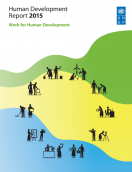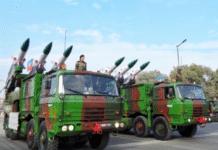NEW DELHI– The United Nations Development Programme (UNDP) in its latest report has placed India’s Human Development Index (HDI) value for 2014 at 0.609, as the country climbed five spots to 130 in a list of 188 countries and territories.
Between 1980 and 2014, India’s HDI value increased from 0.326 to 0.609 — an increase of 68.1 percent or an average annual increase of about 1.54 percent.
 The HDI is a summary measure of assessing long-term progress in three basic dimensions of human development — long and healthy life, access to knowledge and decent standard of living.
The HDI is a summary measure of assessing long-term progress in three basic dimensions of human development — long and healthy life, access to knowledge and decent standard of living.
“India loses 28.6 percent HDI due to inequalities, largely due to inequalities in education (42.1 percent). Among BRICS, South Africa has the highest loss due to inequalities at 35 percent and lowest is for Russia at 10.5 percent,” said a note circulated with the report.
On the Gender Inequality Index (GII), India ranks 130 out of 155 countries with a value of 0.563.
The GII reflects gender-based inequalities in three dimensions — reproductive health, empowerment and economic activity.
The 2015 Global Human Development report by UNDP, named “Work for Human Development”, was released on Monday in Ethiopia.
The report encourages governments to look beyond jobs to consider the many kinds of work such as unpaid care, voluntary or creative work that are important for human development.
As per the report, 2 billion people have moved out of low human development levels in the last 25 years.
The report shows that providing universal social protection in India could cost an estimate 4 percent of GDP.
Between 2000 and 2010, the number of direct jobs in information and communications technology in India jumped from 284,000 to more than 2 million.
As per the data provided in the report, only 39 percent of women in India were internet users compared to 61 percent of men in 2013.
The report cites that off-grid solar photovoltaic technologies will generate 90 direct and indirect jobs per megawatt in India.
For India, unpaid work, predominantly performed by women, is estimated at 39 percent of GDP.
It further stated that India’s workforce participation of women is declining — from 35 percent in 1990 to 27 percent in 2013.
In 38 countries, including India, Pakistan, Mexico and Uganda, 80 percent women were unbanked.
Globally, 74 million youth were unemployed. In India, over 10 percent of youth were unemployed, the report says.
Haoliang Xu, assistant administrator and director of UNDP’s Regional Bureau for Asia and the Pacific, said: “The availability and quality of work are key for human development in Asia and the Pacific, a region that is home to two-thirds of the world’s working-age population.
“In order to ensure that the work-force is capable of adapting to rapidly changing demands, the governments need to make strategic investments into education and health care.”
Commending the Indian government for its leadership role in the design and adoption of the Sustain Development Goals, Yuri Afansasiev, UN resident coordinator and UN resident representative in India, said: “With national development programmes like the National Rural Employment Guarantee Act, Skill India, Digital India, and Make in India in place, the government of India is on a strong footing for the SDGs.
“A greater focus on work, especially for women and youth will undoubtedly ensure success in the achievement of Agenda 2030.”






